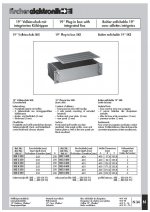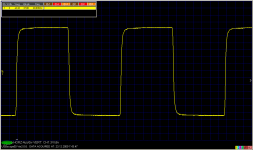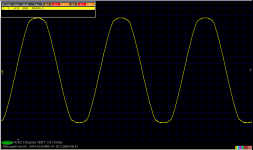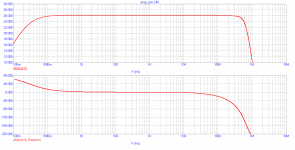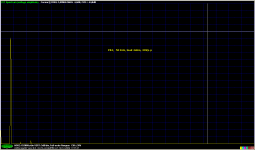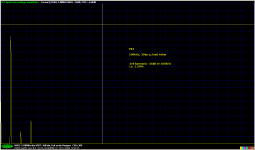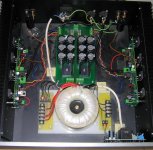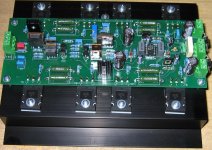ok pma,
that looks very nice.
now you know we are drooling to see the insides.
(besides the picture on the website, of course)
😀
mlloyd1
that looks very nice.
now you know we are drooling to see the insides.
(besides the picture on the website, of course)
😀
mlloyd1
This is the functional sample built:
Last edited:
Pavel,
very nice!
Tell me is it possible to buy these cases, especially the top cover is very nice with lot of hole for air convection, that one would be very expensive if ordered from some company(?).
100 W trannies for M1, 2 was unexpected..
Cheers Michael
very nice!

Tell me is it possible to buy these cases, especially the top cover is very nice with lot of hole for air convection, that one would be very expensive if ordered from some company(?).
100 W trannies for M1, 2 was unexpected..
Cheers Michael
of course they would, but not many specify a 100W FET for a VAS stage.They would withstand 100mA without any problem,,
I am referring to a more normal 5W to 7W BJT for the VAS stage, and said as much in my reply. That cannot pass 100mA bias and withstand +-50Vdc supply rails.
It might be interesting to show how the amplifier works under clipping conditions. The amp is supplied by 2 x 27.5V PSU and loaded by 4ohm. 1st screenshot shows undistorted output swing, and the second shows clipping. One may see that the clipping is soft, and if it happens, it does not create the typical harsh clipping sound.
Attachments
The clipping behaviour is doubted by some as unimportant. This may be true when they listen to highly compressed music.
Excellent recordings of classical music, like Telarc e.g., have often very high dynamic range, long silent parts followed by dynamic booms. In this case, amplifier may very easily get clipped, especially with less sensitive speakers. Example of such recording is Telarc CD-80271, Berlioz - Symphonie Fantastique, Marche to the Scaffold - have a look at the image.
Excellent recordings of classical music, like Telarc e.g., have often very high dynamic range, long silent parts followed by dynamic booms. In this case, amplifier may very easily get clipped, especially with less sensitive speakers. Example of such recording is Telarc CD-80271, Berlioz - Symphonie Fantastique, Marche to the Scaffold - have a look at the image.
Attachments
I know exactly what you mean... I listen exclusively to Classical (haven't that recording version though) and it's surprising when you scope across speakers just what the peaks can be.
Have you ever tried... for listening of course, not specifications... adding a series output resistor in the 0.22 to 0.47 range.
I used to use Celestion SL6's (82db 1watt) and getting 40 volts or so peak across the speaker was easily achieved on classical even though the average power was far far lower. Since use larger floorstanders at around 92db/watt... folk don't understand speaker efficiency makes far more of a difference than changing from a 20 or 30 watt amp to a 100 watt.
I have Mozart piano sonatas (Andras Shiff... old London Label) on CD with some real "infra bass" on it... very surprising.
It's a very impressive result all round... a real world amplifier.
Have you ever tried... for listening of course, not specifications... adding a series output resistor in the 0.22 to 0.47 range.
I used to use Celestion SL6's (82db 1watt) and getting 40 volts or so peak across the speaker was easily achieved on classical even though the average power was far far lower. Since use larger floorstanders at around 92db/watt... folk don't understand speaker efficiency makes far more of a difference than changing from a 20 or 30 watt amp to a 100 watt.
I have Mozart piano sonatas (Andras Shiff... old London Label) on CD with some real "infra bass" on it... very surprising.
It's a very impressive result all round... a real world amplifier.
Have you ever tried... for listening of course, not specifications... adding a series output resistor in the 0.22 to 0.47 range.
I used to use Celestion SL6's (82db 1watt) and getting 40 volts or so peak across the speaker was easily achieved on classical even though the average power was far far lower. Since use larger floorstanders at around 92db/watt... folk don't understand speaker efficiency makes far more of a difference than changing from a 20 or 30 watt amp to a 100 watt.
I have Mozart piano sonatas (Andras Shiff... old London Label) on CD with some real "infra bass" on it... very surprising.
It's a very impressive result all round... a real world amplifier.
Thanks for your kind words, Mooly.
I have tried the resistors of some 0.1R - 0.47R, but not for 'serious' purposes, just curious what would happen sonically.
I would say that for some bass drivers the series resistor might help to obtain the optimum Q of the bass driver, but I am afraid that for a multiway loudspeaker box as a whole the series resistor would change amplitude response.
Regarding infrasound frequencies - the DC servo design must handle them and it is very appreciated to have such CDs (if it is not a mastering mistake) to test DC coupled amp behaviour.
Regards,
Last edited:
That's a good point on the DC servo and infra sound... I too use a servo and it causes a peak in the response below around 4 hz or so from memory... perhaps I should increase the time constant ? but then the settling time becomes long... longer relay delay needed on output... always a compromise isn't it.
I do use a series 0.22 ohm... it seems to suit well on prolonged listening for my set up... and helps isolate the amp a little too. Many say it modifies the response in much the a valve amp with transformer output does... you can tweak forever though.
I do use a series 0.22 ohm... it seems to suit well on prolonged listening for my set up... and helps isolate the amp a little too. Many say it modifies the response in much the a valve amp with transformer output does... you can tweak forever though.
Looks good... do you find a need for a speaker relay switch on delay or is it pretty silent on powering up and down ?
Main sense for using of relay isn't demand of silence, but protection function ( if amp isn't protected by other form )...
The output realy is already installed, but protection circuits are not tuned yet, so they are inactive now.
Regarding initial thump, it is better to use delayed speaker connection by relay. Not absolutely necessary, but better to use it.
Regarding initial thump, it is better to use delayed speaker connection by relay. Not absolutely necessary, but better to use it.
- Status
- Not open for further replies.
- Home
- Amplifiers
- Solid State
- Solid Solid State Power Amplifier
